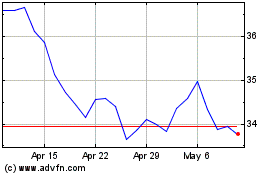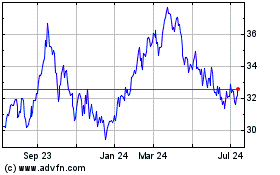Ford Boasts Buoyant Chinese Car Sales in 2015
January 08 2016 - 2:40PM
Dow Jones News
Ford Motor Co. is the second Detroit auto maker to say it ended
last year on a high note in China, reporting a 27% increase in
December sales, as automobile demand continues to rebound in the
world's biggest light-vehicle market.
Ford's December performance caps a record year for the No. 2
U.S. auto maker, following a late-year surge by General Motors Co.,
which sells more than three times more vehicles in China than its
smaller crosstown rival.
For the year, Ford's China sales topped 1 million units and
increased 3%, compared with the same period a year ago. The company
said the launch of its Lincoln luxury-car brand in China got off to
a good start in 2015.
The Dearborn, Mich.-based auto maker is a latecomer to China.
GM, Germany's Volkswagen AG and others entered the market with
products decades ago and have been expanding capacity and sales
channels ever since.
Ford will continue to grow its footprint in China, particularly
for a Lincoln premium brand scrambling to catch up to GM's
Cadillac, Daimler AG's Mercedes-Benz, BMW AG and others. Ford's
11,630 Lincoln deliveries in 2015 equaled a fraction of the 79,779
Cadillacs sold over the same period.
Ford aims to have 60 Lincoln dealerships in 50 cities by
year-end, and it will introduce the Continental sedan to the market
this year. The Continental will battle against Cadillac's CT6,
which hits showrooms this year as well.
Outside of the U.S., China is considered one of the most
profitable markets in the world. But China, like a handful of other
emerging markets, provided its share of turbulence to the global
auto industry in 2015.
Long billed as the world's most promising light-vehicle market,
China's rapid auto sales growth slowed, with car companies
reporting sluggish volumes early in the year and rare sales
declines in the summer months. Volumes rebounded in the fourth
quarter of the year, however, as new tax incentives led to what LMC
Automotive calls a "V-shaped rebound."
Local auto makers selling so-called new energy vehicles, such as
electric cars, are benefiting from policies aimed at sparking sales
of more efficient products. SUVs and crossover vehicles—segments
where some non-Chinese auto makers thrive—have also been
strong.
Not every auto maker is enjoying an upswing, however.
Volkswagen, one of the dominant players in China, reported a 2.1%
decline in December and a 3.4% decline over the course of the
year.
VW, rocked by a global diesel-emissions cheating scandal, said
it sold 3.55 million vehicles in China last year, compared with
GM's record 3.61 million. GM reported a 14% increase in December
sales and a 5.2% increase for the year.
Full Chinese light-vehicle sales statistics are due later in
January. Several auto makers posted sales gains in December and the
2015 calendar year, according to a roundup of results published by
WardsAuto.com. Japan's Honda Motor Co. and Nissan Motor Co. were
among the winners in last year's sales chase.
Meanwhile, auto makers and analysts have a muted view on 2016's
prospects. Toyota Motor Co. has led the companies calling for
growth rates this year well below the high-single-digit percentage
increase estimated for 2015. Barclays' auto analyst Brian Johnson
said he expects growth in China to be "at a more tapered level than
earlier in the decade and a lower absolute volume than most would
have expected a year ago."
The sales pace in the final months of last year was sizzling.
Car makers in China shipped about 2.2 million passenger vehicles in
November, a 24% increase over the same period a year earlier. That
jump was largely because of Beijing's halving of the purchase tax
on small cars to 5% from 10%, covering about 70% of the vehicles
sold in China.
Still, analysts are concerned about a glut of capacity. Credit
Suisse for instance, estimates there was a sharper increase in
production than sales in November, helping drive up sales
incentives and stoking fears that a price war in China will
accelerate.
"Optimism for sales activity in the Chinese market has increased
dramatically since the government announced measures to reduce the
vehicle purchase tax," IHS Automotive said in a forecast issued on
Friday. "However, continued stock market volatility may intimidate
some buyers." The firm now expects light vehicle sales growth to
increase 5% to 6% in 2016, enough to add more than 1.3 million
units of additional sales.
Write to Anne Steele at Anne.Steele@wsj.com and John D. Stoll at
john.stoll@wsj.com
(END) Dow Jones Newswires
January 08, 2016 14:25 ET (19:25 GMT)
Copyright (c) 2016 Dow Jones & Company, Inc.
Honda Motor (NYSE:HMC)
Historical Stock Chart
From Mar 2024 to Apr 2024

Honda Motor (NYSE:HMC)
Historical Stock Chart
From Apr 2023 to Apr 2024
